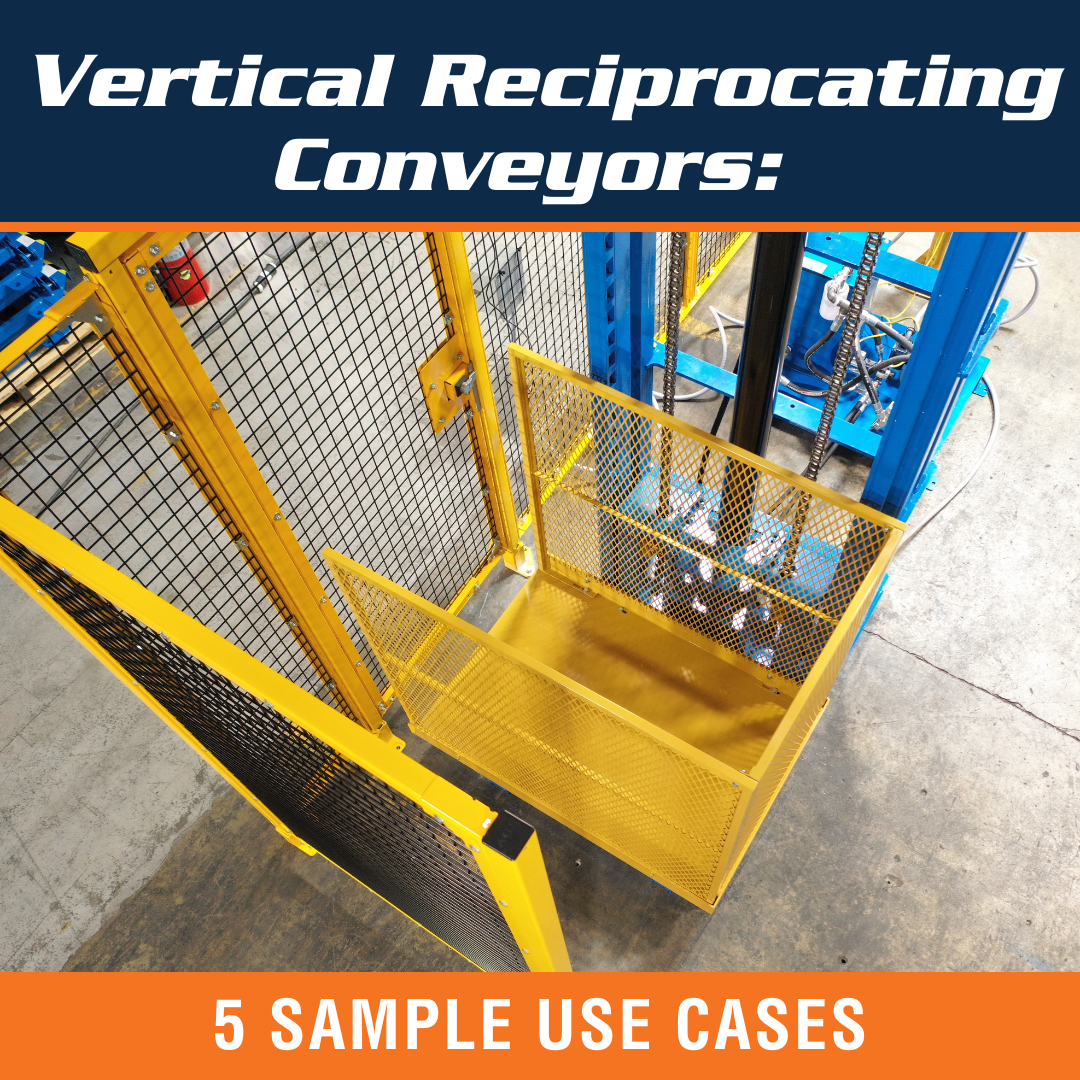We use cookies to make your experience better. To comply with the new e-Privacy directive, we need to ask for your consent to set the cookies. Learn more.
Vertical Reciprocating Conveyors: 5 Sample Use Cases
Vertical material handling is always a challenge. Raising a loaded pallet to mezzanine-level with a forklift can be risky and time-consuming. Freight elevators require costly inspections and frequent, expensive maintenance. It’s not always possible—and it’s rarely safe—to have employees carry heavy loads up and down stairs. 
Permanent material lifts called Vertical Reciprocating Conveyors (VRCs) provide the solution. These custom-designed, custom-built solutions move materials between levels, no matter how many stories your facility occupies.
Vertical Reciprocating Conveyors: A Definition
A Vertical Reciprocating Conveyor (VRC) is a fixed material lift, designed to move pallet loads, products, equipment, and other materials between vertical levels. Unlike a freight elevator, VRCs are suitable only for materials, and cannot transport people. The two classes of equipment follow two distinct safety codes: ASME B20.1 for conveyors and related equipment, versus ASME A17.1 for elevators and escalators.
What does that look like in practice? Here are five sample use cases for VRCs, chosen to get you thinking about the benefits of a VRC at your facility.
1. Manufacturing: Line-Feeding for Elevated Production Equipment
Manufacturing lines often rise to multiple levels—especially those that use gravity hoppers, surge bins, and other bulk material handling equipment. Vertical Reciprocating Conveyors offer a quick, safe way to move raw materials into position at every height.
Install a VRC to send sacks of dry bulk materials to a mezzanine. Use a VRC to send loaded pallets from upper stories to a ground-level shipping/receiving room. Integrate the VRC into your horizontal roller conveyors for a full-facility material handling system. Because every VRC is custom-built to fit the application, the options for vertical material handling are virtually limitless.
2. Warehouse Automation: Transporting AGVs Between Levels
Automation is the next big shift for the warehousing industry, and the simplest way to start is to invest in driverless vehicles. From Automated Guided Vehicles (which follow set tracks) to Autonomous Mobile Robots (which use smart navigation to roam freely), these tools can improve throughput and reduce costs—but only if they can reach their destinations.
When you operate on multiple floors, or use mezzanines to take advantage of vertical space, automated vehicles need an efficient way to travel between levels. Vertical Reciprocating Conveyors are the most cost-effective solution.
3. Retail: Restocking at Multi-Floor Retail Outlets
Flagship stores, shopping malls, big-box outlets: Multi-story retail facilities face serious restocking challenges at upper levels. You could use a freight elevator, but then you face the high costs of safety compliance and regular inspections. You could ask employees to carry box after box up the stairs—but that’s not just slow, it’s also unsafe. The ideal solution is to install a VRC.
Carriages can be built to perfectly handle a loaded pallet. Then it’s just a question of using a forklift or pallet jack to load the VRC, send it to the appropriate level, and start restocking. It’s efficient, productive, and—best of all—safe.
4. Automotive: Elevating Cars at Multi-Story Dealerships
A row of luxury cars in a second, third, or higher window draws buyers in. Multi-story dealerships improve visibility and storage capacity. But to safely operate a high-rise automotive dealership, you need an effective way to move cars between levels.
Vertical Reciprocating Conveyors can be built to handle the thousands of pounds of a typical car or truck. Their cradles can be sized to support these vehicles. A heavy-duty VRC makes the ideal vertical-transportation system for cars at multi-story dealerships.
5. Beverage Production: Raising Kegs and Barrels from Cooling/Aging Cellars
In Kentucky, multi-story warehouses hold millions of barrels of aging spirits. In California, wine-makers use gravity-flow systems to reduce oxidation during the fermentation process. Across the Midwest, breweries mature beer in kegs stored in underground cellars.
All of these beverage producers share the challenge of vertical material handling. What’s the safest, most efficient way to move full barrels and kegs between levels? Again, a custom VRC provides the solution.
